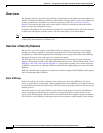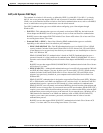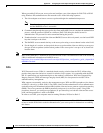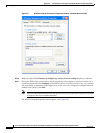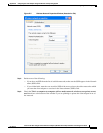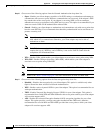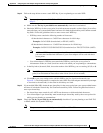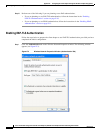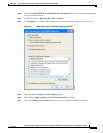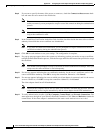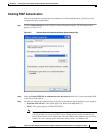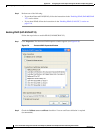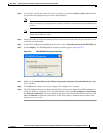
E-8
Cisco Aironet 802.11a/b/g Wireless LAN Client Adapters (CB21AG and PI21AG) Installation and Configuration Guide
OL-4211-03
Appendix E Configuring the Client Adapter through the Windows XP Operating System
Configuring the Client Adapter
Step 10 Choose one of the following options from the Network Authentication drop-down list:
• Open—Enables your client adapter, regardless of its WEP settings, to authenticate and attempt to
communicate with an access point. However, communication can occur only if the adapter’s WEP
key matches that of the access point. If your adapter is not using WEP, it will not attempt to
authenticate to an access point that is using WEP and vice versa. This option is recommended if you
want to use static WEP or EAP authentication without WPA.
• Shared—Enables your client adapter to authenticate and communicate only with access points that
have the same WEP key. Cisco recommends that shared key authentication not be used because it
presents a security risk.
Note Your client adapter’s network authentication setting must match that of the access points
with which it is to communicate. Otherwise, your client adapter may not be able to
authenticate to them.
Note EAP-TLS does not work with shared key authentication because shared key authentication
requires the use of a WEP key, and a WEP key is not set for EAP-TLS until after the
completion of EAP authentication.
• WPA—Enables WPA, which enables your client adapter to associate to access points using WPA.
• WPA-PSK—Enables WPA pre-shared key (WPA-PSK), which enables your client adapter to
associate to access points using WPA-PSK.
Note The WPA-None option is not supported for use with the CB21AG or PI21AG client adapter.
Note Refer to the “WPA” section on page E-4 for more information on WPA and WPA-PSK.
Step 11 Choose one of the following options from the Data encryption drop-down list:
• Disabled—Disables data encryption for your client adapter. This option is available only when
Open or Shared has been selected for Network Authentication.
• WEP—Enables static or dynamic WEP for your client adapter. This option is recommended for use
with open authentication.
• TKIP—Enables Temporal Key Integrity Protocol (TKIP) for your client adapter. This option is
recommended for use with WPA and WPA-PSK unless the access point to which your client adapter
will associate supports AES.
• AES—Enables the Advanced Encryption Standard (AES) encryption algorithm for your client
adapter. This option provides a stronger encryption mechanism than TKIP and is therefore
recommended for use with WPA and WPA-PSK, provided the access point to which your client
adapter will associate supports AES.





